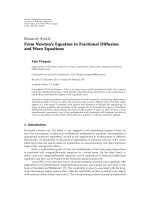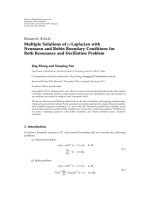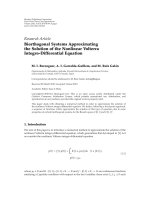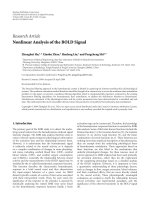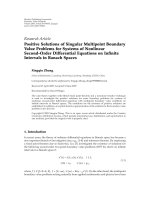Báo cáo hóa học: " Research Article Nonlinear Systems of Second-Order ODEs Patricio Cerda and Pedro Ubilla" ppt
Bạn đang xem bản rút gọn của tài liệu. Xem và tải ngay bản đầy đủ của tài liệu tại đây (486.75 KB, 9 trang )
Hindawi Publishing Corporation
Boundary Value Problems
Volume 2008, Article ID 236386, 9 pages
doi:10.1155/2008/236386
Research Article
Nonlinear Systems of Second-Order ODEs
Patricio Cerda and Pedro Ubilla
Departamento de Matem
´
atica y C. C., Universidad de Santiago de Chile, Casilla 307, Correo 2,
Santiago, Chile
Correspondence should be addressed to Pedro Ubilla,
Received 2 February 2007; Accepted 16 November 2007
Recommended by Jean Mawhin
We study existence of positive solutions of the nonlinear system −p
1
t, u,vu
h
1
tf
1
t, u,v
in 0 , 1; −p
2
t, u,vv
h
2
tf
2
t, u,v in 0, 1; u0u1v0v10, where
p
1
t, u, v1/a
1
tc
1
g
1
u, v and p
2
t, u, v1/a
2
tc
2
g
2
u, v. Here, it is assumed that g
1
,
g
2
are nonnegative continuous functions, a
1
t, a
2
t are positive continuous functions, c
1
,c
2
≥ 0,
h
1
,h
2
∈ L
1
0, 1, and that the nonlinearities f
1
,f
2
satisfy superlinear hypotheses at zero and ∞.
The existence of solutions will be obtained using a combination among the method of truncation, a
priori bounded and Krasnosel’skii well-known result on fixed point indices in cones. The main con-
tribution here is that we provide a treatment to the above system considering differential operators
with nonlinear coefficients. Observe that these coefficients may not necessarily be bounded from
below by a positive bound which is independent of u and v.
Copyright q 2008 P. Cerda and P. Ubilla. This is an open access article distributed under the
Creative Commons Attribution License, which permits unrestricted use, distribution, and
reproduction in any medium, provided the original work is properly cited.
1. Introduction
We study existence of positive solutions for the following nonlinear system of second-order
ordinary differential equations:
−
u
a
1
tc
1
g
1
u, v
h
1
tf
1
t, u, v in 0, 1,
−
v
a
2
tc
2
g
2
u, v
h
2
tf
2
t, u, v in 0, 1,
u0u1v0v10,
1.1
where c
1
, c
2
are nonnegatives constants, the functions a
1
,a
2
: 0, 1→0, ∞ are continuous,
the functions f
1
,f
2
: 0, 1 × 0, ∞
2
→0, ∞ are continuous, and h
1
,h
2
∈ L
1
0, 1. We will
suppose the following four hypotheses.
2 Boundary Value Problems
H
1
We have
lim
uv→0
f
1
t, u, v
u v
0, lim
uv→0
f
2
t, u, v
u v
0, 1.2
uniformly for all t ∈ 0, 1.
H
2
There exist p, q > 1, η
i
> 0, and 0 <α
i
<β
i
< 1fori 1, 2, such that
f
1
t, u, v ≥ η
1
u
p
∀u ≥ 0,t∈
α
1
,β
1
,
f
2
t, u, v ≥ η
2
v
q
∀v ≥ 0,t∈
α
2
,β
2
.
1.3
H
3
The functions g
1
,g
2
: 0, ∞
2
→0, ∞ are continuous and
lim
u→∞
g
i
u, u∞, for i 1, 2. 1.4
In addition, we suppose that there exists an n
∗
∈ N such that g
1
, g
2
are nondecreasing for all
u
2
v
2
≥ n
2
∗
. Here, g
1
, g
2
are nondecreasing, meaning that
g
i
u
1
,v
1
≤ g
i
u
2
,v
2
, for i 1, 2, 1.5
whenever u
1
,v
1
≤ u
2
,v
2
, where the inequality is understood inside every component.
H
4
We have
lim
n→∞
g
1
n, n
n
r/p1
0, lim
n→∞
g
2
n, n
n
r/q1
0, 1.6
where r min{p − 1,q− 1}.
Here are some comments on the above hypotheses. Hypothesis H
1
is a superlinear
condition at 0 and Hypothesis H
2
is a local superlinear condition at ∞. About hypothesis
H
3
, the fact that g
1
, g
2
are unbounded leads us to use the strategy of considering a truncation
system. Note that if g
1
, g
2
are bounded, we would not need to use that system. Hypothesis
H
4
allows us to have a control on the nonlinear operator in system 1.1.
We remark that, the case when a
1
sa
2
s1andg
1
u, vg
2
u, v0, systems
of type 1.1 have been extensively studied in the literature under different sets of conditions
on the nonlinearities. For instance, assuming superlinear hypothesis, many authors have ob-
tained multiplicity of solutions with applications to elliptic systems in annular domains. For
homogeneous Dirichlet boundary conditions, see de Figueiredo and Ubilla 1, Conti et al.
2, Dunninger and Wang 3, 4 and Wang 5. For nonhomogeneous Dirichlet boundary con-
ditions, see Lee 6 and do
´
Oetal.7. Our main goal is to study systems of type 1.1 by
considering local superlinear assumptions at ∞ and global superlinear at zero.
The main result is the following.
Theorem 1.1. Assume hypotheses (H
1
) through (H
4
). Then system 1.1 has at least one positive solu-
tion.
One o f the main difficulties here lies in the facts that the coefficients of the differential
operators of System 1.1 are nonlinear and that they may not necessarily be bounded from
P. Cerda and P. Ubilla 3
below by a positive bound which is independent of u and v. In order to overcome these diffi-
culties, we introduce a truncation of system 1.1 depending on n so that the new coefficient
of the truncation system becomes bounded from below by a uniformly positive constant. See
2.2. This allows us to use a fixed point argument for the truncation system. Finally, we show
the main result proving that, for n sufficiently large, the solutions of the truncation system are
solutions of system 1.1. Observe that, in general, this system has a nonvariational structure.
The paper is organized as follows. In Section 2, we obtain the a priori bounds for the
truncation system. In Section 3, we show that the a priori bounds imply a nonexistence result
for system 2.4.InSection 4, we introduce a operator of fixed point in cones. In Section 5,we
show the existence of positive solutions of the truncation system. In Section 6, we prove the
main result, that is, we show the existence of a solution of system 1.1. Finally, in Section 7 we
give some remarks.
2. A priori bounds for a truncation system
In this section, we establish a priori bounds for the truncation system. The hypothesis H
3
allows us to find a n
∗∗
∈ N so that n ≥ n
∗∗
implies
g
1
u, v ≤ g
1
n, n,g
2
u, v ≤ g
2
n, n, 2.1
for all u
2
v
2
≤ n
2
. Thus, we can define for every n ∈ N, such that n ≥ n
∗∗
, the functions
g
i,n
u, v
⎧
⎪
⎨
⎪
⎩
g
i
u, v if u
2
v
2
≤ n
2
,
g
i
nu
√
u
2
v
2
,
nv
√
u
2
v
2
if u
2
v
2
≥ n
2
,
2.2
for i 1, 2.
In the next section, we will prove the existence of a positive solution for the following
truncation system:
−
u
a
1
tc
1
g
1,n
u, v
h
1
tf
1
t, u, v in 0, 1,
−
v
a
2
tc
2
g
2,n
u, v
h
2
tf
2
t, u, v in 0, 1,
u0u1v0v10.
2.3
For this purpose we need to establish a priori bounds for solutions of a family of systems
parameterized by λ ≥ 0. In fact, for every n ≥ n
∗∗
, consider the family
−
u
a
1
tc
1
g
1,n
u, v
h
1
tf
1
t, u, vλ in 0, 1,
−
v
a
2
tc
2
g
2,n
u, v
h
2
tf
2
t, u, vλ in 0, 1,
u0u1v0v10.
2.4
4 Boundary Value Problems
It is not difficult to prove that every solution of system 2.4 satisfies
ut
1
0
K
1,n
t, s
h
1
sf
1
s, us,vs
λ
ds,
vt
1
0
K
2,n
t, s
h
2
sf
2
s, us,vs
λ
ds.
2.5
Here, K
i,n
t, s, i 1, 2 are Green’s functions given by
K
i,n
t, s
⎧
⎪
⎪
⎪
⎪
⎨
⎪
⎪
⎪
⎪
⎩
1
ρ
i
t
0
a
i
τc
i
g
i,n
uτ,vτ
1
s
a
i
τc
i
g
i,n
uτ,vτ
if 0 ≤ t ≤ s ≤ 1,
1
ρ
i
s
0
a
i
τc
i
g
i,n
uτ,vτ
1
t
a
i
τc
i
g
i,n
uτ,vτ
if 0 ≤ s ≤ t ≤ 1,
2.6
where ρ
i
denotes ρ
i
1
0
a
i
τc
i
g
i,n
uτ.
In order to establish the a priori bound result we need the following two lemmas.
Lemma 2.1. Assume hypotheses (H
2
)and(H
3
). Then every solution of system 2.4 satisfies
ut ≥ q
1
tu
∞
,vt ≥ q
2
tv
∞
, ∀s ∈ 0, 1, 2.7
where q
i
tmin a
i
t1 − t/a
i
∞
c
i
g
i
n, n with i 1, 2.
Proof. A simple computation shows that every solution u, v satisfies
us ≥ q
1
s, u, vu
∞
,vs ≥ q
2
s, u, vv
∞
, ∀s ∈ 0, 1, 2.8
where q
i
s, u, v1/ρ
i
min
s
0
a
i
τc
i
g
i,n
uτ,vτ,
1
s
a
i
τc
i
g
i,n
uτ,vτ}.
Since
q
i
s, u, v ≥
min a
i
s1 − s
a
i
∞
c
i
g
i
n, n
, for i 1, 2, 2.9
we have that 2.7 is proved.
Lemma 2.2. Assume hypotheses (H
2
)and(H
3
). Then Green’s functions satisfy
K
i,n
t, s ≥
min a
i
2
a
i
∞
c
i
g
i
n, n
Gt, s,i 1, 2, 2.10
where
Gt, s
1 − ts, 0 ≤ s<t≤ 1,
1 − st, 0 ≤ t ≤ s ≤ 1.
2.11
P. Cerda and P. Ubilla 5
Theorem 2.3. Assume hypotheses (H
2
)and(H
3
). Then there is a positive constant B
1
which does not
depend on λ, such that for every solution u, v of system 2.4,wehave
u, v
≤ B
1
, 2.12
where u, v u
∞
v
∞
, with u
∞
max
t∈0,1
|ut|.
Proof. By Lemmas 2.1 and 2.2, every solution u, v of system 2.4 satisfies
u, v
≥
min a
1
2
η
1
a
1
∞
c
1
g
1
n, n
β
1
α
1
h
1
su
p
sds
min a
2
2
η
2
a
2
∞
c
2
g
2
n, n
β
2
α
2
h
2
sv
q
sds
≥ c
u
p
∞
v
q
∞
,
2.13
where c min{min a
1
p2
α
p
1
1−β
1
p
η
1
/a
1
∞
c
1
g
1
n, n
p1
β
1
α
1
h
1
sds, min a
2
q2
α
q
2
1−
β
2
q
η
2
/a
2
∞
c
2
g
2
n, n
q1
β
2
α
2
h
2
sds}.
Thus,
1 ≥ c
u
p
∞
v
q
∞
u
∞
v
∞
2.14
which proves 2.12.
3. A nonexistence result
In this section, we see that the a priori bounds imply a nonexistence result for system 2.4.
Theorem 3.1. System 2.4 has no solution for all λ sufficiently large.
Proof. Let u, v be a solution of system 2.4, in other words,
ut
1
0
K
1,n
t, s
h
1
sf
1
s, us,vs
λ
ds,
vt
1
0
K
2,n
t, s
h
2
sf
2
s, us,vs
λ
ds.
3.1
Then,
u, v
≥ λ
1
0
K
1,n
s,
1
2
ds
1
0
K
2,n
s,
1
2
ds
. 3.2
By Theorem 2.3, we know that u, v≤B
1
, thus
λ ≤
B
1
1
0
K
1,n
s, 1/2ds
1
0
K
2,n
s, 1/2ds
, 3.3
which proves Theorem 3.1.
6 Boundary Value Problems
4. Fixed point operators
Consider the following Banach space:
X C
0, 1,
R
×C
0, 1,
R
, 4.1
endowed with the norm u, v u
∞
v
∞
, where u
∞
max
t∈0,1
|ut|. Define the cone
C by
C
u, v ∈ X : u, v0u, v10, yu, v ≥ 0
,
4.2
and the operator F
λ
: X→X by
F
λ
u, vs
A
λ
u, vs, B
λ
u, vs
, for s ∈ 0, 1, 4.3
where
A
λ
u, vs
1
0
K
1,n
s, τ
h
1
τf
1
τ,uτ,vτ
λ
dτ,
B
λ
u, vs
1
0
K
2,n
s, τ
h
2
τf
2
τ,uτ,vτ
λ
dτ.
4.4
Note that a simple calculation shows us that the fixed points of the operator F
λ
are the
positive solutions of system 2.4.
Lemma 4.1. The operator F
λ
: X→X is compact, and the cone C is invariant under F
λ
.
Proof Outline. The compactness of F
λ
follows from the well-known Arzel
´
a-Ascoli theorem. The
invariance of the cone C is a consequence of the fact that the nonlinearities are nonnegative.
In Section 5, we will give an existence result of the truncation system 2.3. The proof
will be based on the following well-known fixed point result due to Krasnosel’skii, which we
state without proof compare 8, 9.
Lemma 4.2. Let C be a cone in a Banach space, and let F : C→C be a compact operator such that
F00. Suppose there exists an r>0 verifying
a u
/
tFu, for all u r and t ∈ 0, 1; suppose further that there exist a compact homotopy
H : 0, 1 × C→C and an R>rsuch that
b FuH0,u, for all u ∈ C;
c Ht, u
/
u, for all u R and t ∈ 0, 1
;
d H1,u
/
u, for all u≤R.
Then F has a fixed point u
0
verifying r<u
0
<R.
P. Cerda and P. Ubilla 7
5. Existence result of truncation system (2.3)
The following is an existence result of the truncation system.
Theorem 5.1. Assume hipotheses (H
1
) through (H
3
). Then there exists a positive solution of s ystem
2.3.
Proof. We will verify the hypotheses of Lemma 4.2.LetC the cone defined in Section 4 and
define the homotopy H : 0, 1 × C→C by
H
t, u, v
s
A
λ
t, u, vs, B
λ
t, u, vs
, for s, t ∈ 0, 1, 5.1
where λ is a sufficiently large parameter, and where
A
λ
t, u, vs
1
0
K
1,n
s, τ
h
1
τf
1
τ,uτ,vτ
tλ
dτ,
B
λ
t, u, vs
1
0
K
2,n
s, τ
h
2
τf
2
τ,uτ,vτ
tλ
dτ.
5.2
Note that Ht, u, v is a compact homotopy and that H0,u,vF
0
u, v, which verifies b.
On the other hand, we have
F
0
u, v
≤
a
1
∞
c
1
g
1
n, n
1
0
h
1
τ
f
1
τ,uτ,vτ
uτvτ
dτ
u, v
a
2
∞
c
2
g
2
n, n
1
0
h
2
τ
f
2
τ,uτ,vτ
uτvτ
dτ
u, v
.
5.3
Taking u, v δ with δ>0sufficiently small, from hypothesis, we have
F
0
u, v
<
u, v
, 5.4
which verifies a of Lemma 4.2.ByTheorem 2.3, we clearly have c.
Finally, choosing λ sufficiently large in the homotopy Ht, u, we see that condition d
of Lemma 4.2 is satisfied by Theorem 3.1. The proof of Theorem 5.1 is now complete.
6. Proof of main result Theorem 1.1
The proof of Theorem 1.1 is direct consequence of the following.
Theorem 6.1. Assume hypotheses (H
1
) through (H
4
). Then there exists an n
0
∈ N such that every
solution u, v of system 2.4 with n>n
∗∗
satisfies
u, v
<n
2
0
. 6.1
8 Boundary Value Problems
Proof. For otherwise, there would exist a sequence of solutions {u
n
,v
n
}
n
of system 2.4 such
that u
n
,v
n
≥n
2
, for all n ∈ N with n>n
∗∗
. Using the same argument as in Theorem 2.3,we
would obtain the estimate
1 ≥ min
min a
1
p2
α
p
1
1 − β
1
p
η
1
a
1
∞
c
1
g
1
n, n
p1
β
1
α
1
h
1
sds,
min a
2
q2
α
q
2
1 − β
2
q
η
2
a
2
∞
c
2
g
2
n, n
q1
β
2
α
2
h
2
sds
u
p
∞
v
q
∞
u
∞
v
∞
.
6.2
We have u
n
∞
u
n
2
∞
v
n
2
∞
sin θ
n
and v
n
∞
u
n
2
∞
v
n
2
∞
cos θ
n
with θ
n
∈
0,π/2. Moreover, there exists a constant c>0 such that sin
p
θ
n
cos
q
θ
n
>c.Then
1
n
min{p−1,q−1}
≥ min
min a
1
p2
α
p
1 − β
p
η
1
c
a
1
∞
c
1
g
1
n, n
p1
β
1
α
1
h
1
sds,
min a
2
q2
α
q
1 − β
q
η
2
c
a
2
∞
c
2
g
2
n, n
q1
β
2
α
2
h
2
sds
,
6.3
which is impossible, since lim
n→∞
n
r/p1
/a
1
∞
c
1
g
1
n, n ∞ and lim
n→∞
n
r/q1
/
a
2
∞
c
2
g
2
n, n ∞ by hypothesis H
4
.
7. Remarks
i We note that the solutions of nonlinear system 1.1 are of C
1
functions in 0, 1 and C
2
almost every where, in 0, 1. Note also that when h
1
t, h
2
t are continuous functions, the
solutions of system 1.1 are classic.
ii A little modification of our argument may be done to obtain an existence result of
the following more general system:
−
u
a
1
tc
1
g
1
u, v
k
1
t, u, v in 0, 1,
−
v
a
2
tc
2
g
2
u, v
k
2
t, u, v in 0, 1,
u0u1v0v10,
7.1
where k
1
, k
2
satisfy H
2
. In addition, we must assume that there exist continuous functions
f
1
,
f
2
: 0, 1 × 0, ∞
2
→0, ∞ satisfying H
1
and H
2
, and nonnegative functions h
1
,h
2
∈
L
1
0, 1, so that for all t ∈ 0, 1,
k
1
t, u, v ≤ h
1
t
f
1
t, u, v,k
2
t, u, v ≤ h
2
t
f
2
t, u, v. 7.2
Acknowledgment
The authors are supported by FONDECYT, Grant no. 1040990.
P. Cerda and P. Ubilla 9
References
1 D. G. de Figueiredo and P. Ubilla, “Superlinear systems of second-order ODE’s,” to appear in Nonlinear
Analysis: Theory, Methods ’ Applications.
2 M. Conti, L. Merizzi, and S. Terracini, “On the existence of many solutions for a class of superlinear
elliptic systems,” Journal of Differential Equations, vol. 167, no. 2, pp. 357–387, 2000.
3 D. R. Dunninger and H. Wang, “Existence and multiplicity of positive solutions for elliptic systems,”
Nonlinear Analysis: Theory, Methods & Applications, vol. 29, no. 9, pp. 1051–1060, 1997.
4 D. R. Dunninger and H. Wang, “Multiplicity of positive radial solutions for an elliptic system on an
annulus,” Nonlinear Analysis: Theory, Methods & Applications, vol. 42, no. 5, pp. 803–811, 2000.
5 H. Wang, “Existence and nonexistence of positive solutions for quasilinear systems,” Boundary Value
Problems, vol. 2006, Article ID 71534, 9 pages, 2006.
6 Y H. Lee, “Multiplicity of positive radial solutions for multiparameter semilinear elliptic systems on
an annulus,” Journal of Differential Equations, vol. 174, no. 2, pp. 420–441, 2001.
7 J. Marcos do
´
O, S. Lorca, and P. Ubilla, “Local superlinearity for elliptic systems involving parameters,”
Journal of Differential Equations, vol. 211, no. 1, pp. 1–19, 2005.
8 M. A. Krasnosel’skii, Positive Solutions of Operators Equations, Noordhoff, Groningen, The Netherlands,
1964.
9 D. J. Guo and V. Lakshmikantham, Nonlinear Problems in Abstract Cones,vol.5ofNotes and Reports in
Mathematics in Science and Engineering, Academic Press, Boston, Mass, USA, 1988.


